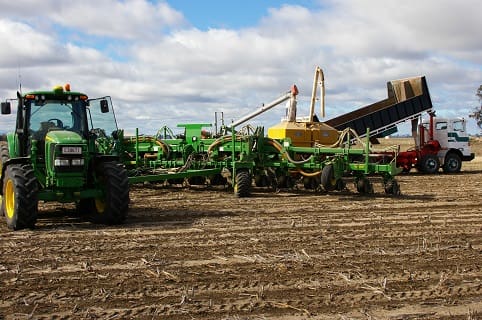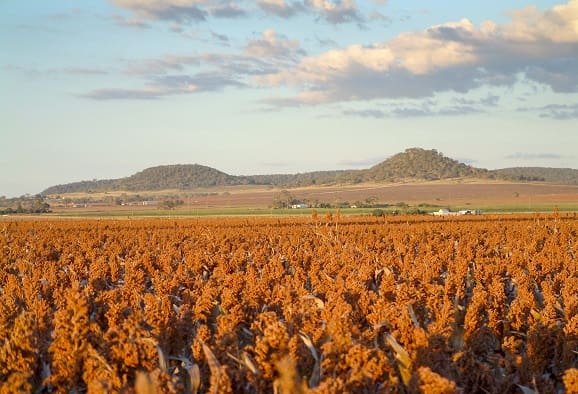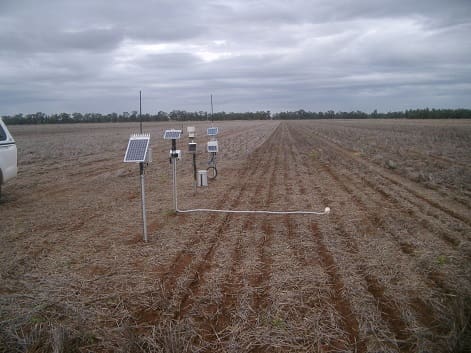
Grain growers are being urged to accurately calculate available soil moisture to determine the risk versus potential of summer crop planting. (Photo: GRDC)
CALCULATING soil moisture will be a critical consideration in summer crop planting decisions this season with wide spread rain continuing to prove elusive across large areas of Queensland and northern New South Wales.
Below average rainfall this year severely restricted winter planting opportunities and has left growers weighing up their options for the summer cropping season.
Significant and widespread rain to restore soil moisture levels will play a key role in dictating planting decisions, according to CSIRO principal research scientist Dr Jeremy Whish.
“Calculating available soil moisture is a risk management tool: avoiding a failed crop saves money now and saves stored moisture for future crops,” Dr Whish said.
The Grains Research and Development Corporation (GRDC) in partnership with CSIRO has invested in research looking at the benefits of setting profitable crop yield targets, calculating the amount of water needed to achieve these yield targets and assessing that against available stored soil moisture and the potential for in-crop rainfall.
Dr Whish said having a target helps guide grower decision-making and allows them to compare the risk of planting in the current conditions, against future planting opportunities when conditions may be more favourable.
“Planting later increases the length of fallow allowing time to store water in the soil before planting but it has other flow on effects such as reducing options for double crops and reducing fallow length for the next crop. These issues must be considered from a whole of farm management perspective,” he said.
“If stored water is moderate it may pay to wait and store additional water or, alternatively, consider planting a shorter season crop with lower water requirements.”
How much water does a summer crop really need?
When calculating soil moisture levels, Dr Whish said it was critical growers understood the water requirements of a crop.
For example, approximately 166 millimetres of water is required to grow a tonne of sorghum in the Condamine region of south west Queensland.
Dr Whish said around 100mm of this water would be used to establish the plant or lost as evaporation while the remaining 66mm will be used to produce grain at an average of 15 kilograms per mm.
“In some seasons this conversion will be better (around 28kg/mm) and in other years it will be worse (around 6kg/mm). The conversion rate changes because it depends on factors such as temperature, humidity and the timing of rainfall,” he said.
“The water provided to the crop can come from water stored in the soil during the fallow or from in-crop rain.”

To make an informed decision growers need to understand the water requirements of a crop like sorghum in their specific region. (Photo: GRDC)
Calculating soil moisture and potential yield
“When making a decision stored water can be measured, but in-crop rainfall is unknown. This is why estimating a final yield based on the water stored in the soil plus a conservative estimate of potential in-crop rainfall is a good way of assessing the risk of planting a crop.”
Dr Whish said calculating potential crop yields based on total rainfall and soil water works as a simple estimate and guide for planting decisions, with the impact of rainfall timing on crop productivity able to be better gauged by sophisticated modelling tools such as APSIM and Yield Prophet.
Using an example target yield of 2.4t/ha on a Brigalow soil in the Condamine region, the amount of water required would be:
2400 (kg/ha) divided by 15 = 160 mm of water for grain + 100 mm for establishment and evaporation = 260 mm. Therefore, the total water requirement is 260mm.
“If the current amount of water stored in the soil is 100mm (approx. 60cm wet soil by push probe) then 160mm needs to fall during the crop growing period. As a rough guide for a November planting at Condamine, the average rainfall during the growing season would be around 244mm and there is an 80 per cent chance of getting at least 158mm,” Dr Whish said.
Using an example target yield of 3.0t/ha on a Vertosol around Burren Junction, the amount of water required would be:
3000 (kg/ha) divided by 15 = 200 mm of water for grain + 100 mm for establishment and evaporation = 300 mm. Therefore, the total water requirement is 300mm.
“Calculating available soil moisture is a risk management tool: avoiding a failed crop saves money now and saves stored moisture for future crops.”
“If the current amount of water stored in the soil is 100mm (approx. 60cm wet soil by push probe) then 200 mm needs to fall during the crop growing period. As a rough guide for a November planting at Burren Junction, the average rainfall during the growing season would be around 224mm and there is an 80 per cent chance of getting at least 125mm,” Dr Whish said.
He explained water stored during the fallow had a higher value than rainfall because it was available when the plant needed it and it was already there. Rain short fall in the calculation above still has to ‘arrive’ and the use of averages give no indication if it will come when needed.
“I have been conservative presenting an 80 per cent probability. Every season is unique and the use of the SOI combined with long season forecasts can help assess the risk while different planting strategies, row configuration or stagged sowing dates, can be used to offset risk,” Dr Whish said.
“Deciding whether to plant or not is difficult, experience and gut feel are valuable components of this decision, however, by following some of the approaches presented here the decision can be made more transparent and justifiable.
“By thinking about the consequences of the planting decision on future crops, and how this crop fits into the overall whole farm system, the best decision will be made.
“In terms of risk management, the greatest value of stored water is in knowing the quantity available for crop production, before the crop is planted, when decisions are being made.”

Estimating a final yield based on stored water is more accurate than using estimated in-crop rainfall. (Photo: GRDC)
Key points for calculating soil moisture
- Stored soil water can be measured while in-crop rainfall can only be estimated based on probabilities and historical climate data.
- Summer crop planting decisions should be based on what is known.
- Risk can be reduced by setting profitable crop yield targets, calculating the amount of water needed to achieve these yield targets and assessing that against available stored soil moisture and the probability of receiving additional moisture through in-crop rainfall.
Source: GRDC
Useful resources:
Water Extraction, Water-Use And Subsequent Fallow Water Accumulation In Summer Crops https://bit.ly/2AxCiVn
Tips For Summer Crop Planting In Dry Times https://bit.ly/2OcsYty
Soil Water – Methods To Predict Plant Available Water Capacity (PAWC) Using Soil-Landscape Associations https://bit.ly/2qhqlgK
Soil Moisture Probe Network – Using Soil Water Information To Make Better Decisions On The Eyre Peninsula https://bit.ly/2vheCkr
Grain Central: Get our free daily cropping news straight to your inbox – Click here

HAVE YOUR SAY